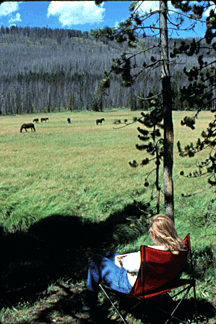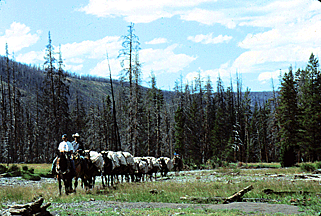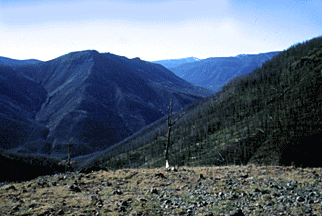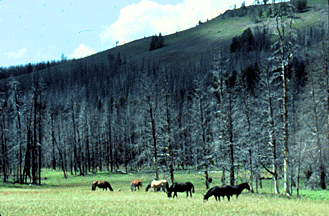 We
awoke the next day to sunshine and preceded to dry out things out. I
explored the surrounding environment while my trek mates lounged in the
bright sunshine that warmed the Mist Creek Valley. We
awoke the next day to sunshine and preceded to dry out things out. I
explored the surrounding environment while my trek mates lounged in the
bright sunshine that warmed the Mist Creek Valley.
After a day of rest, we started out again on one of the most grueling
parts of the trip. Packing began at sunrise. Each bag had to be weighed and
each mule loaded with care.
We rode up along the rim of Mist Creek Valley, at times high above the
sound of rushing water and then down to where it flowed into the rock-strewn
Lamar River. The trail became rocky and rough to ride, especially the
downhill side. The Park Service had planted logs horizontally across the
trail to prevent erosion. The trail, marked with orange squares on the
trees, looked somewhat surrealistic.
Trees had fallen everywhere and many lay over the trail causing us to
skirt around. Our horses were often skittish about going through the rough
timber. At times, some, like mine, just refused.
 We
stopped for lunch along the banks of the Lamar River to wait for our pack
train to pass. The river rocks were smoothed by constant rolling in the
waters. Bright red-orange Indian Paint Brush, Wyoming's state flower,
bloomed everywhere. We
stopped for lunch along the banks of the Lamar River to wait for our pack
train to pass. The river rocks were smoothed by constant rolling in the
waters. Bright red-orange Indian Paint Brush, Wyoming's state flower,
bloomed everywhere.
After lunch, we began our ascent. This was one of the most difficult
trails for both man and horse. We climbed nearly 2,000 feet straight up 50
or so switchbacks through a number of different forest environments. With
our horses huffing and puffing, we had to stop often. The rocky terrain
caused them to slip a lot and at some points it didn't seem as if they would
make it. My horse was breathing so heavily I thought she would fall over in
her tracks. Yellow-green seedlings had sprouted all around us.
"Forests in the Lamar Valley are underlain by volcanic rock with
lots of plant nutrients," said Despain. "Those nearer to Mammoth
Hot Springs are poor soils that don't support wildflower and tree growth as
easily. Lodgepole pine forests have fewer species of flora and fauna,
anyway."
 When
we reached the top, we rode over a bald, rocky promontory from which the
land dropped off a sudden 2,000 feet or more into the valley. The
view was tremendous but I hardly enjoyed it, so scared was I that my horse
would lose her footing and we'd both tumble to our deaths. We rode over the
top of the ridge, full of scorched subalpine fur trees at 9,600 feet, for
several miles with views of the valley and a deep canyon far below to our
left. When
we reached the top, we rode over a bald, rocky promontory from which the
land dropped off a sudden 2,000 feet or more into the valley. The
view was tremendous but I hardly enjoyed it, so scared was I that my horse
would lose her footing and we'd both tumble to our deaths. We rode over the
top of the ridge, full of scorched subalpine fur trees at 9,600 feet, for
several miles with views of the valley and a deep canyon far below to our
left.
For the next two days we camped in a high mountain meadow on top of a
glacial moraine at 9,300 feet just across the park border in Shoshone
National Forest high above Frost Lake. This cool, dry alpine meadow,
punctuated by an ice-cold mountain spring, connected what was once
tree-covered hills. Fire had scorched many of the surrounding trees, but
there were enough green ones to offer cover. It seemed as if I could reach
up and touch the sky.

Alex and the other wranglers let the horses and mules roam free. Some had
bells around their necks. It sounded a bit like Switzerland in the still
night air. After a supper of spaghetti and salad followed by brownies and
coffee, we gazed at the stars and the Milky Way, twinkling above, as if in a
planetarium.
Our camp lay beside another badly burned section. Piles of sand, dropped
by Chinook helicopters during the fire's peak, were all that remained of
that valiant effort. Fireweed, the first plant to grow after a fire,
decorated the feet of black and silver gray tree trunks with its carpet of
bright pink flowers.
Next: Days
5 & 6
|
